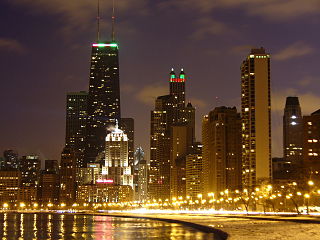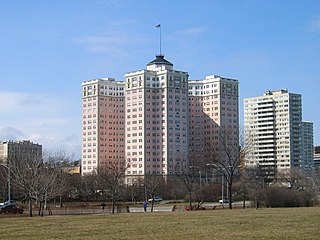
The Bryn Mawr Historic District is on the lakefront of the Edgewater neighborhood of far-north Chicago, Illinois. It extends along Bryn Mawr Avenue between Broadway Avenue and Sheridan Road. Its most prominent features are the Belle Shore Apartment Hotel, Bryn Mawr Apartment Hotel, Edgewater Beach Apartments, Edgewater Presbyterian Church, Manor House, and the northernmost area of Lincoln Park.

The Belmont–Sheffield Trust and Savings Bank Building is a six-story building built in 1928 at 1001 W. Belmont Avenue, Chicago, Illinois. The building was designed by architect John Nyden and is on the National Register of Historical Places. It was constructed in a U-shape around a two-story central atrium, which allowed light to reach the bank lobby—the glass atrium has since been roofed over.

Aqua is an 82-story mixed-use residential skyscraper in the Lakeshore East development in downtown Chicago, Illinois. Designed by a team led by Jeanne Gang of Studio Gang Architects, with James Loewenberg of Loewenberg & Associates as the Architect of Record, it includes five levels of parking below ground. The building's eighty-story, 140,000 sq ft (13,000 m2) base is topped by a 82,550 sq ft (7,669 m2) terrace with gardens, gazebos, pools, hot tubs, a walking/running track and a fire pit. Each floor covers approximately 16,000 sq ft (1,500 m2). The Aqua was awarded the Emporis Skyscraper Award as 2009 skyscraper of the year, and was shortlisted in 2010 for the biennial International Highrise Award. In celebration of the 2018 Illinois Bicentennial, Aqua was selected as one of the Illinois 200 Great Places by the American Institute of Architects Illinois component and was recognized by USA Today Travel magazine, as one of AIA Illinois' selections for Illinois 25 Must See Places.
There are more than 350 places listed on the United States National Register of Historic Places in Chicago, Illinois, including 83 historic districts that may include numerous historic buildings, structures, objects and sites. This total is documented in the tables referenced below. Tables of these listings may be found in the following articles:

The Oregon Public Library is located in Oregon, Illinois, United States, the county seat of Ogle County. The building is a public library that was constructed in 1909. Prior to 1909, Oregon's library was housed in different buildings, none of which were designed to house a library. The library was built using a grant from wealthy philanthropist Andrew Carnegie. The grant was obtained after Oregon's citizens voted to change Oregon's library from a city library to a township library. The building was completed by 1908 but the library did not begin operation until 1909.
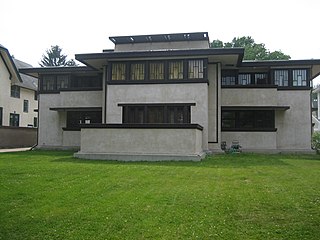
The Frank Lloyd Wright/Prairie School of Architecture Historic District is a residential neighborhood in the Cook County, Illinois village of Oak Park, United States. The Frank Lloyd Wright Historic District is both a federally designated historic district listed on the U.S. National Register of Historic Places and a local historic district within the village of Oak Park. The districts have differing boundaries and contributing properties, over 80 of which were designed by Frank Lloyd Wright, widely regarded as the greatest American architect to have ever lived.

Pullman National Monument, also known as The Pullman District and Pullman Historic District, is located in Chicago and was the first model, planned industrial community in the United States. The district is significant for its historical origins in the Pullman Company, one of the most famous company towns in the United States, and scene of the violent 1894 Pullman strike. It was built for George Pullman as a place to produce the famous Pullman sleeping cars.

Loop Retail Historic District is a shopping district within the Chicago Loop community area in Cook County, Illinois, United States. It is bounded by Lake Street to the north, Ida B. Wells Drive to the south, State Street to the west and Wabash Avenue to the east. The district has the highest density of National Historic Landmark, National Register of Historic Places and Chicago Landmark designated buildings in Chicago. It hosts several historic buildings including former department store flagship locations Marshall Field and Company Building, and the Sullivan Center. It was added to the National Register of Historic Places on November 27, 1998. It includes 74 contributing buildings and structures, including 13 separately listed Registered Historic Places, and 22 non-contributing buildings. Other significant buildings in the district include the Joffrey Tower, Chicago Theatre, Palmer House, and Page Brothers Building. It also hosts DePaul University's College of Commerce, which includes the Kellstadt Graduate School of Business and the Robert Morris College.
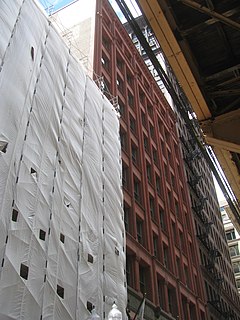
The Silversmith Hotel is a boutique hotel located in downtown Chicago, Illinois. It occupies the historic Silversmith Building, designed in 1896 by Peter J. Weber of the architectural firm of D.H. Burnham and Company, who also designed the Fisher Building. The building's architecture reflects the transition from Romanesque Revival architecture to Chicago school architecture. The Silversmith Building was listed on the National Register of Historic Places in 1997.
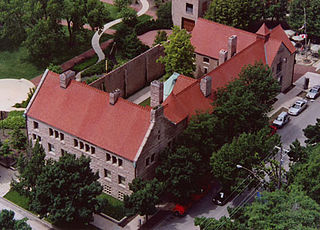
Prairie Avenue is a north–south street on the South Side of Chicago, which historically extended from 16th Street in the Near South Side community area of Chicago in Cook County, Illinois, United States, to the city's southern limits and beyond. The street has a rich history from its origins as a major trail for horseback riders and carriages. During the last three decades of the 19th century, a six-block section of the street served as the residence of many of Chicago's elite families and an additional four-block section was also known for grand homes. The upper six-block section includes part of the historic Prairie Avenue District, which was declared a Chicago Landmark and added to the National Register of Historic Places.

The Garden Homes Historic District is a residential historic district located in the Chatham neighborhood of the South Side, Chicago, Illinois. The district includes 152 residential buildings, 88 of which are contributing buildings, built in 1919-20 as Chicago's first large housing project. The newly formed Chicago Housing Association, a group of 22 prominent Chicago businessmen that included J. Ogden Armour, Charles H. Wacker, and William Wrigley, Jr., planned the homes as an affordable housing project for working-class Chicagoans. At the time, the city was suffering from a post-World War I housing crisis, and many of its working-class residents lived in tenements or other unlivable housing. Architect Charles Sumner Frost designed the homes, which were mainly brick cottages and stucco duplexes. The houses were built on unusually large lots for the time; the extra land was designed to serve as garden space for residents.

Joseph William Royer (1873–1954) was a prolific architect from Urbana, Illinois who designed many prominent buildings in Urbana, Champaign, and beyond. His work included civic, educational, commercial, and residential buildings, many of which are listed in the National Register of Historic Places and feature a wide variety of architectural styles.
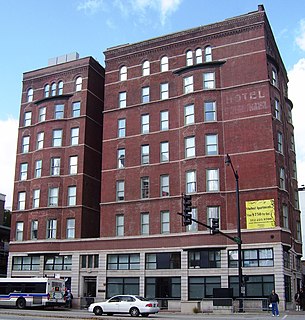
The Somerset Hotel is a historic hotel building located at 1152-1154 S. Wabash Ave. in downtown Chicago, Illinois. Built in 1892–93, the hotel was originally owned by physician Frank Stringfield. Architect Jules De Horvath designed the hotel in the Romanesque Revival style. De Horvath's design bore similarities to many other Chicago buildings, most notably the 1888 Virginia Hotel at Ohio and Rush Streets. The Somerset Hotel was a significant part of a hotel and commercial district which formed between the 12th Street station on the South Side Elevated Railroad and Central Station. The hotel changed its name to the Mayer Hotel in 1910; in the 1920s, it again changed its name to the Hotel Roosevelt, which it was called until the 1990s.

The Deer Path Inn is a historic hotel, originally named Deerpath Inn because of its previously location, is now located at 255 E. Illinois Road in Lake Forest, Illinois.
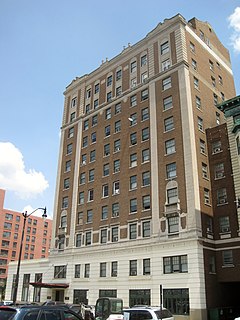
The St. Nicholas Hotel is a historic hotel building located at 400 E. Jefferson St. in Springfield, Illinois, US.

The Logan Square Boulevards Historic District is a linear historic district in the Logan Square community area of North Side, Chicago. It encompasses 2.5 miles (4.0 km) of the Chicago boulevard system.

The Urbana-Lincoln Hotel – Lincoln Square Mall is a historic building complex located at 300 South Broadway Avenue in Urbana, Illinois. The Tudor Revival style hotel was built in 1923. In 1964, the mall was built as an extension of the hotel; it was one of the first fully enclosed shopping malls in Illinois. The hotel, the mall, and the building complex was listed on the National Register of Historic Places in 2006. As of October 2017, the mall was still in operation, however the hotel was closed.
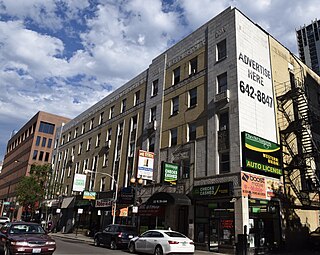
The Mark Twain Hotel is a historic residential hotel located at 111 W. Division Street in the Near North Side community area of Chicago, Illinois. Built in 1930 by developer Fred Becklenberg, the hotel was one of several residential hotels built to house the influx of labor to Chicago in the late 1920s. Most of the hotel's residents were permanent; according to 1940 census records, the majority had been at the hotel for over five years. Architect Harry Glube designed the hotel in the Art Deco style, a departure from the revival styles normally used for residential hotels. The brick building features extensive terra cotta detailing, including an elaborate cornice and stringcourse above and below the fourth floor.
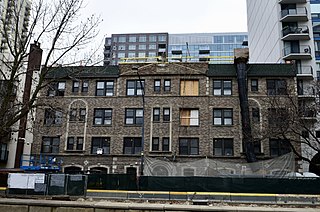
The Marshall Hotel is a historic residential hotel located at 1232 N. LaSalle Street in the Near North Side neighborhood of Chicago, Illinois. Built in 1927, the hotel was one of several residential hotels built to house an influx of workers to Chicago in the 1920s. While the hotel offered rooms to both temporary and permanent residents, census records indicate that most of its residents were permanent. Architect Edmund Meles, who designed several hotels and apartment buildings in Chicago in the 1920s, designed the building in a mix of the Classical Revival and Renaissance Revival styles. The building has a brick exterior and features a limestone arched entrance, arched lintels with keystones around the first-floor windows, limestone quoins, and a pediment with an urn.

The Fred Hottes House in Boise, Idaho, is a 2-story, sandstone and shingle Colonial Revival house designed by Tourtellotte & Co. and constructed in 1908. The house features a cross facade porch and a prominent, pedimented front gable. The house was added to the National Register of Historic Places in 1982.


